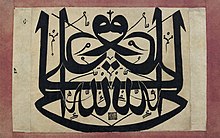spect, but other religious art such as glass mosque lamps and other mosque fittings such as tiles, woodwork and carpets usually have the same style and motifs as contemporary secular art, although with reIslamic art is not at all restricted to religious art, but includes all the art of the rich and varied cultures of Islamic societies as well. It frequently includes secular elements and elements that are frowned upon, if not forbidden, by some Islamic theologians. Apart from the ever-present calligraphic inscriptions, specifically religious art is actually less prominent in Islamic art than in Western medieval art, with the exception of Islamic architecture where mosques and their complexes of surrounding buildings are the most common remains. Figurative painting may cover religious scenes, but normally in essentially secular contexts such as the walls of palaces or illuminated books of poetry. The calligraphy and decoration of manuscript Qu'rans is an important aligious inscriptions even more prominent.
jueves, 8 de diciembre de 2011
Islamic Art
spect, but other religious art such as glass mosque lamps and other mosque fittings such as tiles, woodwork and carpets usually have the same style and motifs as contemporary secular art, although with reIslamic art is not at all restricted to religious art, but includes all the art of the rich and varied cultures of Islamic societies as well. It frequently includes secular elements and elements that are frowned upon, if not forbidden, by some Islamic theologians. Apart from the ever-present calligraphic inscriptions, specifically religious art is actually less prominent in Islamic art than in Western medieval art, with the exception of Islamic architecture where mosques and their complexes of surrounding buildings are the most common remains. Figurative painting may cover religious scenes, but normally in essentially secular contexts such as the walls of palaces or illuminated books of poetry. The calligraphy and decoration of manuscript Qu'rans is an important aligious inscriptions even more prominent.
Suscribirse a:
Enviar comentarios (Atom)


No hay comentarios:
Publicar un comentario